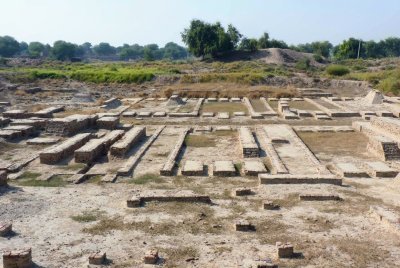Pakistan
Archaeological Site of Harappa
The archaeological site of Harappa comprises the ruins of a Bronze Age fortified city and is the first excavated site of the eponymous civilization.
The Harappan or Indus Valley Civilization is one of the earliest civilizations in the Near East and Indian region. At its greatest extent between 2600 and 1900 BCE, Harappa occupied an area of 150 hectares and had more than 23,000 inhabitants.
Site Info
Official Information
- Full Name
- Archaeological Site of Harappa (ID: 1878)
- Country
- Pakistan
- Status
-
On tentative list 2004
Site history
History of Archaeological Site of Harappa
- 2008: Incomplete - not examined
- The Archaeological sites of Mehrgarh, Rehman Dheri and Harappa as an extension of the Archaeological Ruins of Mohenjodaro
- 2004: Added to Tentative List
- Added to tentative list
- 1980: Rejected
- .
- Type
- Cultural
- Criteria
Links
- UNESCO
- whc.unesco.org
All Links
UNESCO.org
- whc.unesco.org — whc.unesco.org
Community Information
- Community Category
- Archaeological site: South (East) Asian
Travel Information
Recent Connections
News
No news.
Recent Visitors
- henryjiao18
- Mihai Dascalu
- shoaibmnagi
- Alexander Lehmann
- Roger Ourset
- Stanislaw Warwas
- Thomas Buechler
Visitors of Archaeological Site of Harappa
Community Reviews
Show full reviews
I visited this archaeological site by private car from Lahore, it is 200km or about 4 hours to drive. The Harappans used the same type of bricks as in its sister city of Mohenjo-daro, but this more famous WHS site was unfortunately closed due to the recent flooding in Southern Pakistan.
Hidden under layers of mud and soil lies one of the most sophisticated towns of the third millennium BC. Excavations were carried out from 1872-1995, and parts of the objects are now displayed in the on-site museum, and in the Lahore museum. There is a big range of animal&bird figurines made out of terracotta. Rhinoceros, a humped bull, and the mythical unicorn are plentiful, and they were also incorporated in the manufacturing of seals. The museum should be visited first, then the trail around the mounds. There I learnt that at the North end of Mound AB even a earlier Ravi Hakra Phase of civilization (3900-2800 BC) was discovered.
A Terracotta chess board has been found as well, it might be the oldest one ever excavated anywhere!
I paid a small entrance fee, and a security guard accompanied me by motorbike, the path is paved, but it was really hot on that day.
Keep reading 0 comments
Harappa is the “other” Indus Valley site – it has always suffered in comparison with Moenjodaro due to the fact that the site was plundered in the 1850s by British railway builders who found that its bricks made excellent ballast and thus unwittingly destroyed a large part of it. Nevertheless it has the “honour” of being used in the title often used to describe the entire Indus Valley civilisation – viz “Harappan”. This because the very first hints of the existence of such a people first emerged from there in the form of seals of unknown provenance. Archaeological digging also commenced there first – but it was really the uncovering of Moenjodaro which provided the “proof”. The 2 sites were generally contemporaneous across approx 2600BCE to 1300 BCE
If you have already seen Moenjodaro then Harappa is inevitably going to be something of a disappointment. The extent of the site and its remains are much smaller and they lack iconic archaeological features such as the “Great Bath”. Those aspects which are on view might seem a bit minor and esoteric to a non-enthusiast!
a. The “Mortimer Wheeler” Trench where you can actually view the multiple levels of occupation (Mortimer Wheeler was a UK archaeologist who became director of Archaeological survey of India and later in the 1950s/60s was a very early Radio/TV “personality” - his name/persona is thus well known to “older” UK citizens!)
b. A well and bathing platforms – mirroring the Moenjodaro “Great Bath” in …
Keep reading 0 comments